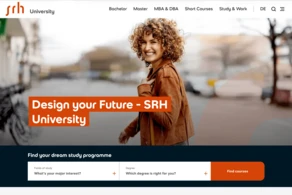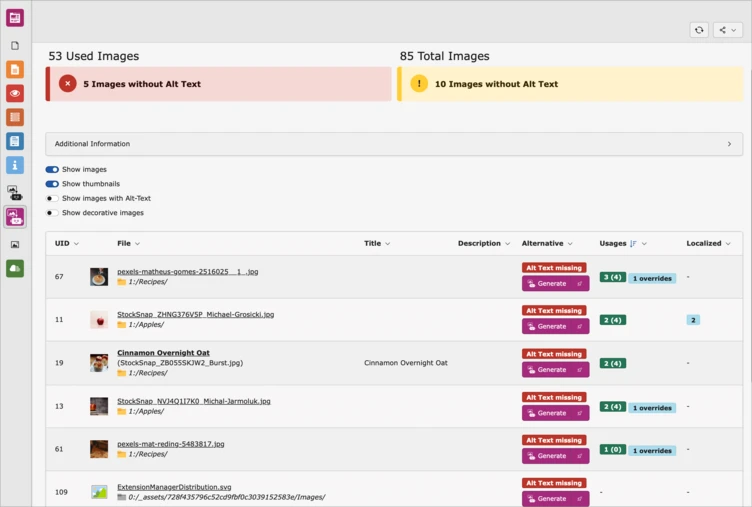SRH University: AI-powered website accessibility with Descriptive Images

When faced with new accessibility regulations and a vast library of digital assets, what’s a complex organization to do? Our answer: an innovative AI-powered solution that automatically generates alt-text descriptions in both German and English.
SRH University is part of SRH, founded in 1966, one of Germany’s leading providers in the education and healthcare sectors. With universities, schools, hospitals, and rehabilitation centers, SRH supports around 1.2 million people annually at over 80 locations across the country. As a modern and dedicated university, SRH University of Applied Sciences Heidelberg currently supports more than 9,500 students across over 200 competency-based degree programs – actively shaping the academic future in Germany.
When digital accessibility became law
When Germany’s new digital accessibility law—the Accessibility Improvement Act or “Barrierefreiheitsstärkungsgesetz” (BFSG)—required the university to add descriptive text to over 15,000 images by June 2025, they turned to their long-standing technology partner b13 to avoid months of manual work.
The result: an AI tool that enabled the whole SRH foundation to meet the legal deadline while streamlining their content workflow for the future.
We spoke with Christoph Möckel, the Marketing Manager responsible for SRH University’s homepage, about how b13 helped solve a seemingly impossible challenge.
The challenge began with an imminent compliance deadline: The BFSG was coming into effect on June 28, 2025. This digital accessibility law requires websites to be fully accessible to people with disabilities, including providing alternative text descriptions for all images so screen readers can describe visual content to users.
For most businesses, this might be manageable. But SRH University’s website contained between 15,000 and 20,000 images spanning everything from professors’ headshots to decorative graphics and logos. “We would have had to manually describe all of these images in both German and English,” explains Christoph. “From an editorial perspective, that simply wouldn’t have been feasible for us.”
The timeline made the situation even more pressing. SRH University was about to enter a major website relaunch to consolidate multiple university websites following a recent merger. They needed a solution that could efficiently handle the scale while maintaining quality standards across two languages—all while their team focused on the continual improvement of the new website.
For SRH, there was no question about who to ask for help. The organization had been working with b13 for nearly eight years, building what Christoph describes as a “trusting, constructive, and pragmatic” partnership.

Automation through AI
Rather than simply accepting the manual workload, b13 introduced SRH to their Descriptive Images AI tool that could automatically generate alt-text descriptions for images. “Our big requirement was that—since our site is in German and English with language switching—we needed it to work not just in German, but also generate the English descriptions,” Christoph explains.
b13 implemented the solution directly into SRH’s TYPO3 content management system through an API integration—right within SRH’s existing workflow. Editors can now access and manage alt-text descriptions through the same interface they already use for all other content.
The process b13 followed was systematic and transparent. “First, they worked closely with us to clarify exactly what needed to be done. They thoroughly reviewed everything and then presented it as clear solution concepts. b13 also estimated the effort in hours, providing a solid budget framework to ensure it didn't get out of hand.”
What makes the Descriptive Images AI tool especially valuable is that it future-proofs accessibility. It doesn’t just handle existing images, but automatically generates alt-text for every new image uploaded to the system. For SRH’s editors, this means compliance is now built into their daily workflow rather than being an additional burden.
The implementation also included practical guidance.
Deadlines met, workflows totally transformed
The results speak for themselves. SRH met the June 28, 2025 deadline for digital accessibility compliance, maintained their reputation as an organization committed to serving people with disabilities—and still managed to stay on track with their website relaunch.
“We would probably still be writing alt-text descriptions now if we didn’t have this tool,” Christoph reflects. “And we probably wouldn’t have managed to meet the deadline without having to pull massive staff resources from other areas.”
The system now provides editors with a backend view showing all images with and without alt-text descriptions, making it easy to maintain compliance over time. Beyond simply meeting legal requirements, the AI solution has fundamentally improved how SRH manages content. “We can now trust the tool’s information without double-checking a spreadsheet five times,” says Christoph.
For SRH, the project exemplified what they value most about working with b13.
The partnership continues to evolve. SRH and b13 are now working on further improvements to the user experience, including enhancements to their course finder and other features that will make the website even more accessible.
Facing your own accessibility challenge?
b13’s combination of TYPO3 expertise and innovative solutions can help you turn regulatory challenges into competitive advantages.
Digital accessibility requirements are becoming mandatory across Europe, and the scale of compliance can seem overwhelming. If your organization needs to implement these features quickly and efficiently—whether for legal reasons, better user experience, or reaching new audiences—get in touch.
Contact b13 to discuss how they can help streamline your digital accessibility implementation to keep your team focused on what matters most to your business.

